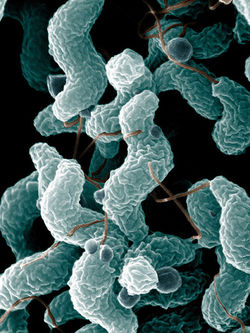Difference between revisions of "Campylobacter species - Overview"
| Line 11: | Line 11: | ||
The bacteria are curved, Gram negative rods with polar flagellum to aid motility. The daughter cells remain joined, giving a gull-wing or spiral appearance. They are microaerophilic and sensitive to drying. | The bacteria are curved, Gram negative rods with polar flagellum to aid motility. The daughter cells remain joined, giving a gull-wing or spiral appearance. They are microaerophilic and sensitive to drying. | ||
| − | Campylobater species can be divided into; Thermophilic species, including ''C. jejuni and C. coli'' and Non-thermophilic species e.g. ''C. fetus''. | + | Campylobater species can be divided into; Thermophilic species, including ''C. jejuni and C. coli'' and Non-thermophilic species e.g. [[Campylobacter fetus subspecies fetus|''C.fetus'']]. |
They can grow on enriched selective media e.g. Skirrow agar in 1-10% carbon dioxide and 5-10% oxygen tension. Many grow on MacConkey, however ''C. jejuni'' requires increased temperatures for growth. | They can grow on enriched selective media e.g. Skirrow agar in 1-10% carbon dioxide and 5-10% oxygen tension. Many grow on MacConkey, however ''C. jejuni'' requires increased temperatures for growth. | ||
| − | ''C. fetus'' subspecies ''venerealis'' and subspecies ''fetus'' have small, round, smooth, translucent colonies. | + | [[Campylobacter fetus subspecies fetus|''C.fetus'']] subspecies ''venerealis'' and subspecies ''fetus'' have small, round, smooth, translucent colonies. |
''C. jejuni'' has small, flat, grey colonies with watery appearance. | ''C. jejuni'' has small, flat, grey colonies with watery appearance. | ||
Smears are stained with dilute carbol fuschin for 4 minutes. | Smears are stained with dilute carbol fuschin for 4 minutes. | ||
==Pathogenesis and pathogenicity== | ==Pathogenesis and pathogenicity== | ||
| − | ''C. fetus'' subspecies ''fetus'' and subspecies ''venerealis'' possess a microcapsule (S layer) which resists phagocytosis and serum-mediated destruction and enhances survival in the genital tract. | + | ''C. fetus'' subspecies [[Campylobacter fetus subspecies fetus|''fetus'']] and subspecies ''venerealis'' possess a microcapsule (S layer) which resists phagocytosis and serum-mediated destruction and enhances survival in the genital tract. |
Antigens of the S layer undergo antigenic shifts in ''C. fetus'' subspecies ''venerealis'', allowing persistence in the host. | Antigens of the S layer undergo antigenic shifts in ''C. fetus'' subspecies ''venerealis'', allowing persistence in the host. | ||
''C. jejuni'' attaches and invades host enterocytes and produces enterotoxin-like substances. | ''C. jejuni'' attaches and invades host enterocytes and produces enterotoxin-like substances. | ||
The Flagellae of ''C. jejuni'' required for colonisation. | The Flagellae of ''C. jejuni'' required for colonisation. | ||
[[Category:To_Do_-_AimeeHicks]] | [[Category:To_Do_-_AimeeHicks]] | ||
Revision as of 10:49, 14 July 2010
| This article is still under construction. |
Overview
Campylobacter live on the mucosa of the intestinal and genital tract and can be commensals or pathogens. The enteric species cause disease in humans and other species cause infertility and abortion in cattle and sheep. Campylobacteriosis is caused by Campylobacter organisms. C. jejuni and C. lari is excreted in the faeces of birds and pigs and can contaminate water and food supplies. C.fetus is restricted to the bovine prepucial mucosa.
Characteristics
The bacteria are curved, Gram negative rods with polar flagellum to aid motility. The daughter cells remain joined, giving a gull-wing or spiral appearance. They are microaerophilic and sensitive to drying. Campylobater species can be divided into; Thermophilic species, including C. jejuni and C. coli and Non-thermophilic species e.g. C.fetus. They can grow on enriched selective media e.g. Skirrow agar in 1-10% carbon dioxide and 5-10% oxygen tension. Many grow on MacConkey, however C. jejuni requires increased temperatures for growth. C.fetus subspecies venerealis and subspecies fetus have small, round, smooth, translucent colonies. C. jejuni has small, flat, grey colonies with watery appearance. Smears are stained with dilute carbol fuschin for 4 minutes.
Pathogenesis and pathogenicity
C. fetus subspecies fetus and subspecies venerealis possess a microcapsule (S layer) which resists phagocytosis and serum-mediated destruction and enhances survival in the genital tract. Antigens of the S layer undergo antigenic shifts in C. fetus subspecies venerealis, allowing persistence in the host. C. jejuni attaches and invades host enterocytes and produces enterotoxin-like substances. The Flagellae of C. jejuni required for colonisation.
